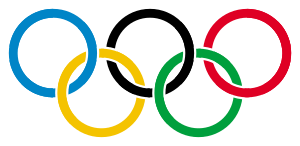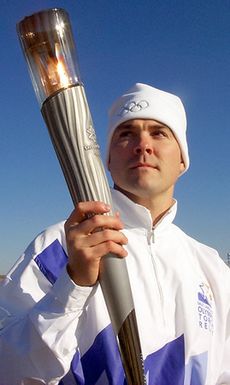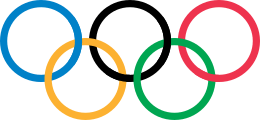Olympic Charter facts for kids
 |
| Organizations |
| Charter • IOC • NOCs • Symbols Sports • Olympic Medals |
| Games |
| Ancient Olympic Games Summer Olympic Games Winter Olympic Games Paralympic Games Youth Olympic Games |
The Olympic Charter is like a rulebook for the Olympic Games. It contains all the rules and guidelines for how the Games are organized. It also explains how the International Olympic Committee (IOC) and the entire Olympic movement should work. The latest version of this rulebook was updated on July 17, 2020. The Charter is written in both French and English.
Contents
Why the Olympic Charter is Important
The Olympic Charter helps guide the Olympic Games and solve any problems that come up. It has three main goals:
- To set out the basic ideas and values of Olympism.
- To act as the official law for the International Olympic Committee (IOC).
- To explain the rights and duties of the main groups involved in the Olympic movement. These groups include the IOC, the International Federations (IFs), the National Olympic Committees (NOCs), and the groups that organize the Olympic Games.
Main Parts of the Charter
The Olympic Charter has 5 chapters and 61 articles, which are like different sections and rules. Here are some of the most important parts that help run the Olympic Games and guide the Olympic movement.
Chapter 1: The Olympic Movement and Its Actions
This chapter talks about what the Olympic movement is all about.
Article 2: The main job of the IOC is to spread the ideas of Olympism around the world. They also lead the Olympic movement. This means they make sure sports are fair and ethical. They encourage people to play sports and ensure the Olympic Games happen regularly. They also work to protect the Olympic movement and help sports grow.
Article 6: The Olympic Games are competitions between athletes, either as individuals or in teams. They are NOT competitions between countries. This means the focus is on the athletes' skills and sportsmanship.
Article 8: The famous Olympic symbol has five rings that are linked together. From left to right, their colors are blue, yellow, black, green, and red. These five rings stand for the five continents of the world coming together.
Chapter 2: The International Olympic Committee (IOC)
This chapter explains who can be a member of the International Olympic Committee (IOC). It also talks about their meetings and the main ideas that guide them.
Chapter 3: The International Federations (IFs)
Chapter 3 explains the role of International Federations (IFs) in the Olympic movement. IFs are international groups that manage specific sports around the world. For example, there's an IF for swimming, one for gymnastics, and so on. These groups make sure their sports follow the Olympic Charter and the spirit of the Olympics. They also decide who can compete and how the competitions are set up.
Chapter 4: The National Olympic Committees (NOCs)
Article 28: The job of the National Olympic Committee (NOCs) is to help the Olympic movement grow in their own countries. They also protect it. NOCs encourage the Olympic spirit and make sure their country follows the Olympic Charter. They also promote fair play and the development of sports. They are in charge of sending their country's athletes to the Games. They also help choose a host city for the Games and work with other groups during the event.
Chapter 5: The Olympic Games
This chapter covers how the Olympic Games are celebrated. It includes how a host city is chosen. It also talks about who can participate in the games. This chapter lists the sports included in the Games. It also discusses media coverage and official publications.
This chapter also explains the rules for Olympic events. This includes how to use the Olympic flag and the Olympic flame. It also covers the opening and closing ceremonies.
Chapter 6: Rules for Problems and Solutions
This chapter explains what happens if rules are broken. It covers how to deal with problems and disagreements.
- Rule 59: Measures and punishments for breaking rules.
- Rule 60: How to challenge decisions made by the IOC.
- Rule 61: How to solve disagreements.
Basic Ideas of Olympism
Olympism is more than just sports. It's a way of life that brings together body, mind, and spirit. It mixes sports with culture and education. It aims for a life based on the joy of trying hard. It also values good examples, being responsible, and respecting everyone.
Here are some key principles:
- Sport for Everyone: Playing sports is a human right. Everyone should be able to play sports. There should be no unfair treatment of any kind. This means playing with friendship, teamwork, and fair play.
- Sport and Society: Sports groups in the Olympic movement can make their own rules. They can also choose their leaders freely. They are responsible for making sure good rules are followed.
- No Discrimination: Everyone should have the same rights and freedoms. This means no unfair treatment based on race, gender, religion, or anything else.
- Following the Rules: To be part of the Olympic Movement, you must follow the Olympic Charter. You also need to be recognized by the IOC.
Protecting the Idea of Olympism
Some people believe that having a strong belief in Olympism should be protected by law. This means that people who truly believe in the values of Olympism should not face unfair treatment. This idea is similar to how followers of religions like Islam or Christianity are protected.
Olympic Congress
The IOC organizes the Olympic Congress. This meeting brings together representatives from all parts of the Olympic Movement. The IOC decides when and where the Congress will happen. It also sets the duties of the Congress president. Members of the IOC, along with delegates from International Federations and National Olympic Committees, attend the Congress. Representatives from other groups recognized by the IOC can also join.
See also
 In Spanish: Carta Olímpica para niños
In Spanish: Carta Olímpica para niños



